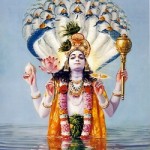Literally the Sanskrit word ‘yoga’ means connection. Here we have two basic meanings: The connection of the soul to Supersoul The connection with one’s own soul The classic yoga is […]

The word “yoga” comes from Sanskrit, where it literally means “union” or “connection”, and originates from a verb root ‘yuj’ (to unite, to connect, to yoke).
The most well known yoga definition comes from the Patanjali Yoga sutras: yogash-citta-vritti-nirodhah (1.2) – ‘yoga is the elimination of mental fluctuations’. So how can we combine these two meanings together: the union and the elimination?
The traditional interpretation of yoga is the union of the individual soul or Atma and the Supersoul or Paramatma. This union or connection may come in various forms and at different levels – according to the state of a yogi’s consciousness.
To be able to achieve this connection, one has to balance their body, mind and intelligence – this is the first step. At this point a person will obtain good health and the peace of mind.
The next step is to harmonize the body and soul. It will help to gain control over the senses, and achieve the internal satisfaction.
After that a yogi can proceed to the next stage – to establish a connection between the soul and the Super soul. Once that connection is there, it is called ‘yoga’ in its full sense.
‘Ashtanga’ means “having 8 limbs. According to the sage Patanjali, the process of yoga has 8 stages (which are followed gradually and combined with each other).
They are as follows:
Yama – the moral codex.
Niyama – the rules of a proper behavior in the society.
Asana – the practice of yoga poses.
Pranayama – one learns how to control their breathing.
Pratyahara – the practice of sense control and withdrawal.
Dharana – a yogi learns how to concentrate their mind.
Dhyana – the meditation.
Samadhi – the state of consciousness, described by Patanjali, when there are no fluctuations in the mind, and the consciousness is united with the object of meditation.
The modern yoga is better known for its poses, breathing exercises and some meditation techniques, while its primary goal shifted substantially towards health improvement, stress reduction and weight loss.
Originally yoga had a few paths (called ‘Marga’ in Sanskrit) following which a person could attain its ultimate goal. These paths are Yoga marga (the path of meditation), Gyana marga (the path of knowledge), Karma marga (the path of action according to Vedic scriptures), and Bhakti marga (the path of devotion and divine love). Other types and styles of yoga developed from these four, such as Hatha yoga, Raja, Laya, Kundalini, etc.
Today we have many great masters and teachers, including Sri T. Krishnamacharya, his disciples BKS Ayengar and Sri Pattabhi Jois, the tradition of Swami Sivananda with his well known disciples Swami Satyananda and Swami Vishnudevananda, the yoga school of Dhirendra Brahmachari, and many others, like Bikram, Kripalu, Anusara, Kali Ray (Triyoga), etc.
Yoga is very accessible to everyone; you simply need to decide which style you are more comfortable with, and start your own practice, be it in a class, a studio or at home.

Literally the Sanskrit word ‘yoga’ means connection. Here we have two basic meanings: The connection of the soul to Supersoul The connection with one’s own soul The classic yoga is […]